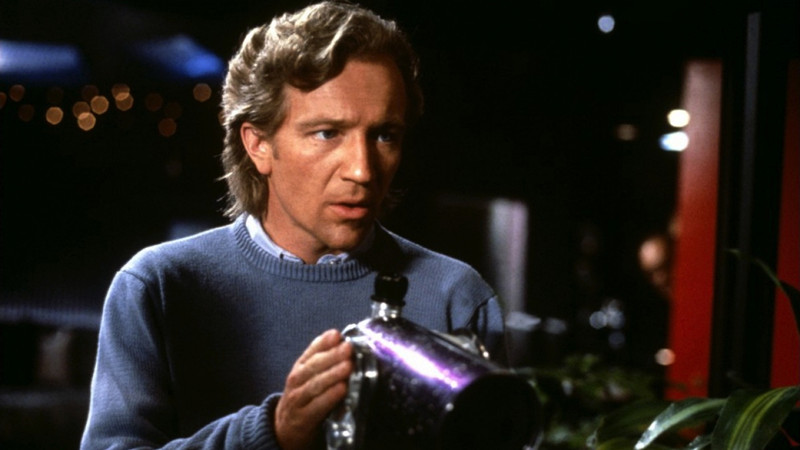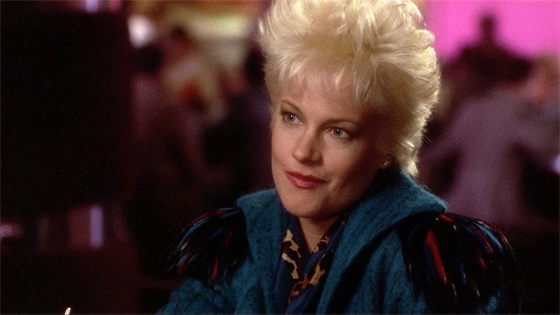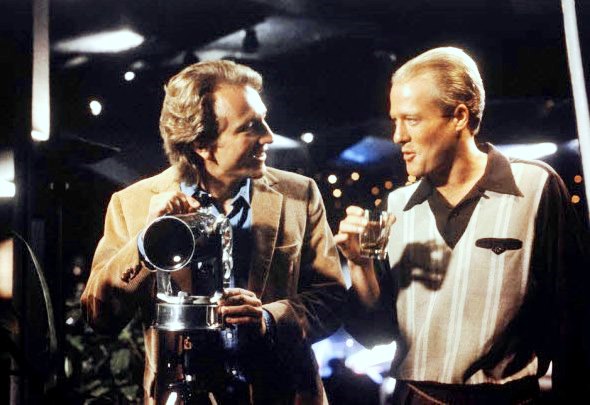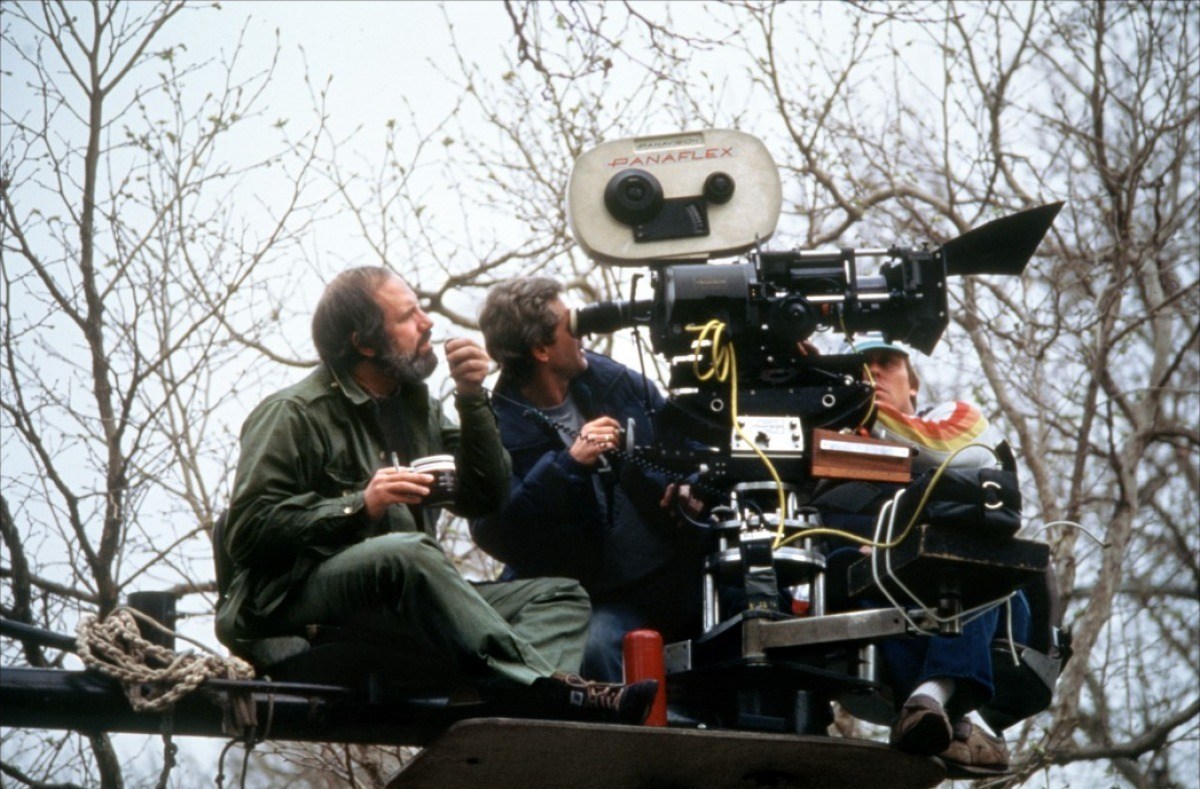
“Movies are so rarely great art that if we cannot appreciate great trash we have very little reason to be interested in them.”
– Pauline Kael
I like to watch
Tout de suite from its opening shot of a pea-soupy cemetery at sunset, a deliberately clichéd title font gauchely and accurately suggests we’re in genre territory.
The camera pulls away, past memorial markers and headstones, then dips underground to find, resting in a coffin, what appears to be a post-punk vampire, maybe on loan from a goth rock outfit.
The vampire in question, we soon find out, is agoraphobe actor Jake Scully (played with barely tempered sleaze by Craig Wasson) on the set of a schlocky B-movie, and surely this sharply informed introduction to Body Double finds director Brian De Palma at his most reflexive and deliriously irreverent.
Jake’s inability to perform the coffin scene in the low-budget fright flick is due to his near-crippling claustrophobia and the movie’s director, Rubin (played with profane perfection by De Palma regular Dennis Franz), puts his production on force majeure so that Jake can get his shit together.
Before you know it Jake comes home from set a little too early only to walk in on his girlfriend cheating on him. If Jake wasn’t feeling inadequate and unavailing before he certainly does now.
Thankfully Jake is saved from self-destruction by his actor pal Sam Bouchard (Gregg Henry), who lines him up with a house-sitting stint in a friend’s ultramodern Hollywood Hills home––in actuality the famous Chemosphere building, a Hollywood landmark designed by architect John Lautner.
Here Sam introduces Jake via telescope to his “favorite neighbor”, a woman who does sexy strip teases in front of her bedroom window with the curtains wide open, of course.
“[Body Double] opens with a satire on vampire movies, includes a Hitchcockian cat-and-mouse sequence, and even borrows some of the clichés of 1940s thrillers, including a detailed recapitulation at the end, complete with flashbacks… De Palma is at home in this genre. He also has, once again, his almost unique courage to go over the top––to push scenes beyond the edge of common sense and into cheerfully heightened and impassioned overkill.”
– Roger Ebert
A sight worth seeing, a vision of you

Body Double is vintage De Palma at his subversive, sleekest, stylishly excessive, and trashiest best. Toying with familiar Hitchcockian themes––both Rear Window and Vertigo are studiously and mercilessly mined––the resulting come-hither thriller is a full-tilt attack of ghoulish exuberance.
Jake’s spying on his racy, exhibitionist neighbor gets obsessive pretty much straight away, and when he thinks her life might be in danger he finds himself in hot water, the kind where a cold shower could come in handy, and suddenly his path crosses and complicates with porn star Holly Body (Melanie Griffith).
Griffith gives a breakout performance in Body Double, she was virtually unknown to audiences at the time, apart from a small but significant role in Arthur Penn’s Night Moves (1975), Griffith was better known as being the daughter of Hitchcock’s muse Tippi Hedren. But that all changed when she became Holly Body, ensuring that 80s cinema was seldom so smart ass, enterprising, and easily as churlish as charming.
“I do not do animal acts. I do not do S&M or any variations of that particular bent, no water sports either. I will not shave my pussy, no fistfucking and absolutely no coming in my face. I get $2000 a day, and I do not work without a contract.”
– Holly Body (Melanie Griffith)
You can’t believe everything you see

It’s tempting, in discussing Body Double, to surrender some of the plot and expose some of the entanglements that permeates the picture, but that would spoil the fun.
This much I’ll concede, the subsequent mystery will have Jake and Holly working together but some gender role reversal makes it all uncertain and delightfully dicey.
This is a film full of twists, turns, incredulity, and intrigue, evolving into a master class in misleads, narrative leaps, flashbacks, panache, and put-ons in an airtight plot that overflows with deceit.
All of De Palma’s hallmarks emerge: stylish split-diopters, wild point-of-view tracking shots, split screen interruptions, feisty femme fatales, over-the-top oddballs, useless lawmen, gallow’s humor, false steps, and faux pas. When not hamming it up as high camp Body Double busies itself as a compendium of film noir flourishes clad in naughty negligees.
In hindsight it’s easy to view Body Double, a film that honestly depicts the “other” big film industry in Tinseltown––the skin flick factory/adult entertainment world––as a harbinger to Paul Thomas Anderson’s breakout sophomore film, the crowd-pleasing porn epic Boogie Nights (1997).
It takes some daring to draw a line from Vertigo to Debbie Does Dallas––with a detour into 1982’s The Slumber Party Massacre––but De Palma does it in stride and with not a shit given.
We need to talk about Brian

“De Palma was actually the first American auteur of the New Hollywood to emerge, but the last to come to prominence (not counting George Lucas, who is hardly an auteur in the true sense). He is also the most gleefully, perversely derivative of them all, and perhaps for this reason the most in tune with the times. De Palma may be the only one of these auteurs—Altman, Coppola, Scorsese, Spielberg—from whom we might still hope for miracles…”
– Jake Horsley, “The Blood Poets”
Early on in De Palma’s career the critics have called him bombastic, overblown, and derivative, but also an expert formalist blessed with technical skills beyond many of his peers. The trashy artifice and often ill-mannered tactility that Body Double exudes is very deliberate.
De Palma’s earlier 80s films––Dressed to Kill (1980), Blow Out (1981), and Scarface (1983)––were hit-and-miss at the box office but each drew considerable controversy for their violent content and exploitation elements. De Palma frequently felt he was pulling his punches to appease the ratings board.
During the filming of Scarface De Palma was interviewed by Esquire and he admirably decried: “I want to be infamous. I want to be controversial. It’s much more colorful… As soon as I get this dignity from Scarface I’m going to go out and make an X-rated suspense porn picture. I’m sick of being censored… So if they want an X they’ll get a real X. They wanna see suspense, they wanna see terror, they wanna see SEX––I’m the person for the job.”
And of course, his next film would be Body Double. Did De Palma, with Body Double, go too far? Joyously so. He proudly thumbed his nose via his middle finger to the establishment that repeatedly condemned and damned his open-ended obsessions with violence and sex on the silver screen. Body Double is an intoxicating and capricious caper that broke new ground as unabashedly breathtaking objet d’art and then some.
So, if you don’t like having the proverbial rug yanked out from under you a couple of times during the course of a single film, watch something safe because the cinema of Brian De Palma, and Body Double in particular, is far too dangerous.
Author Bio: Shane Scott-Travis is a film critic, screenwriter, comic book author/illustrator and cineaste. Currently residing in Vancouver, Canada, Shane can often be found at the cinema, the dog park, or off in a corner someplace, paraphrasing Groucho Marx. Follow Shane on Twitter @ShaneScottravis.